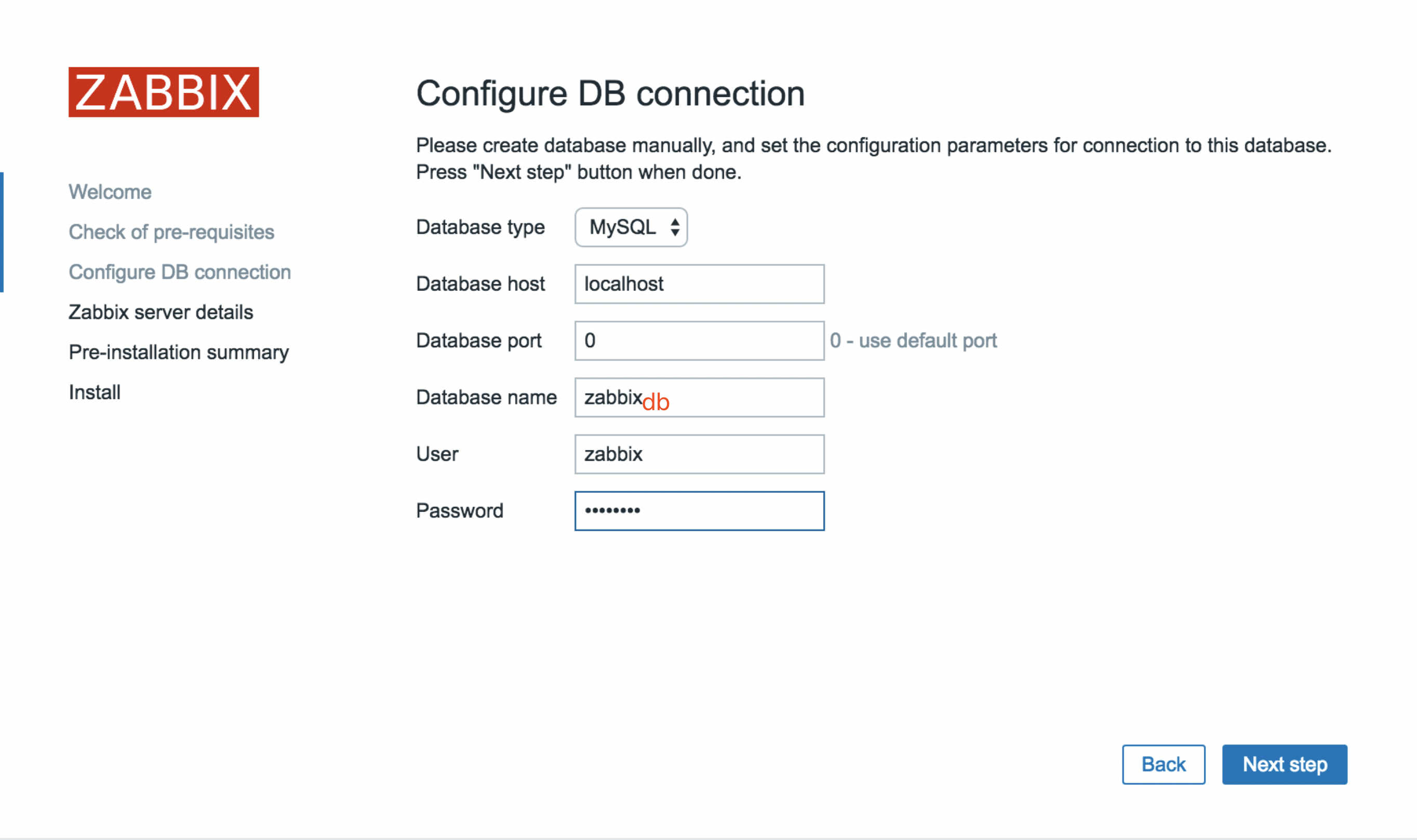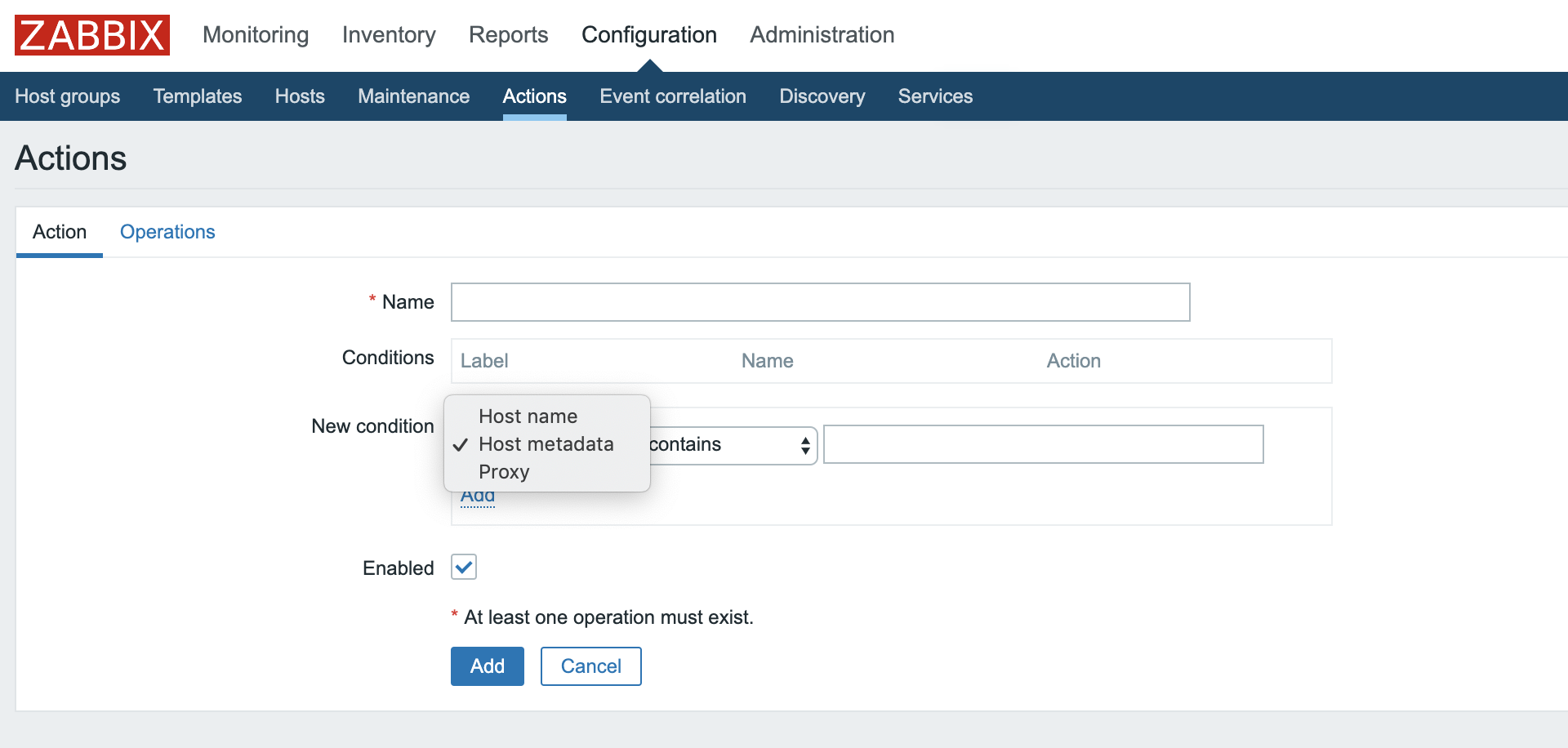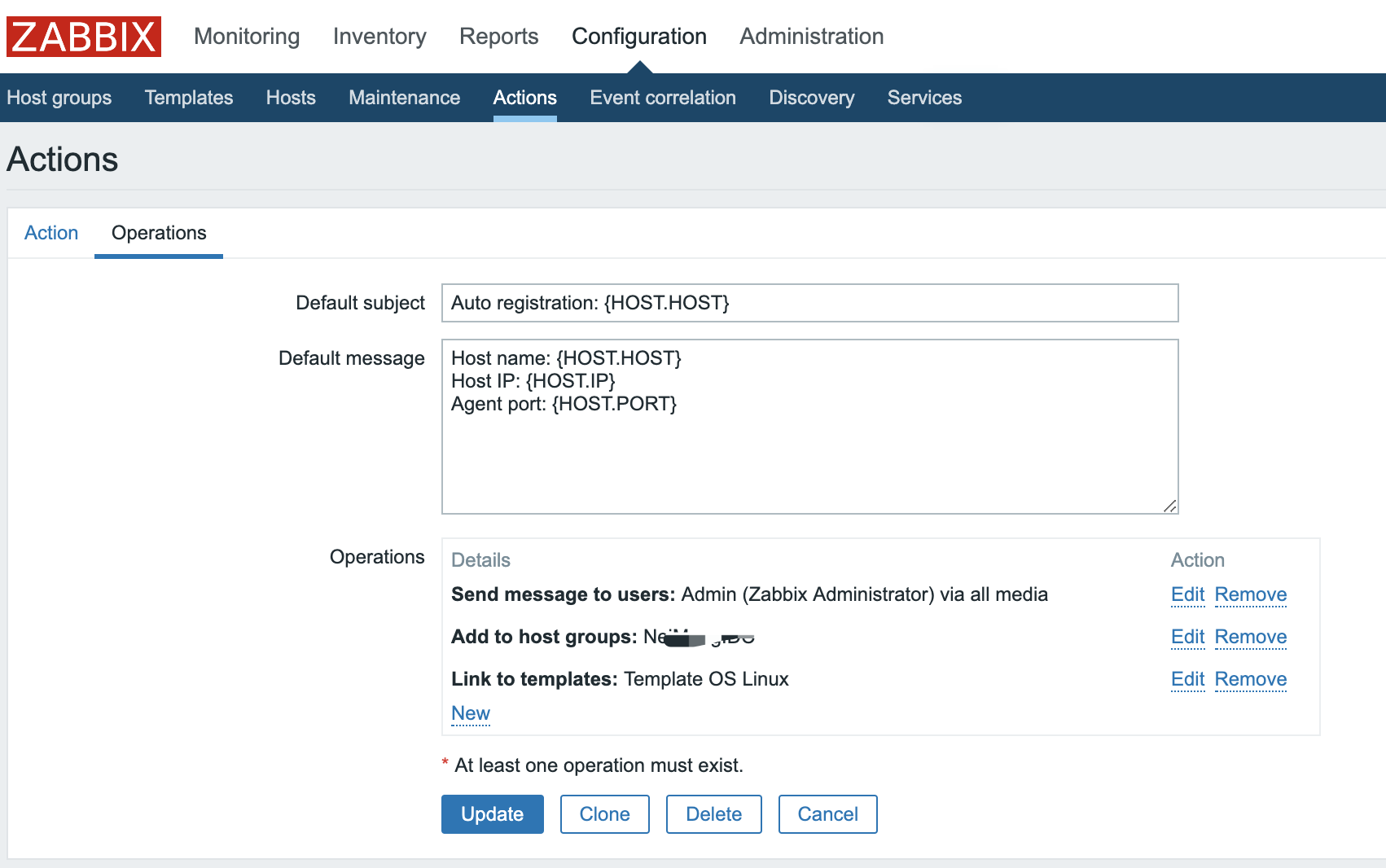ubuntu16.04 安装zabbix-server和zabbix-agent
一、必要条件
0、必要条件
zabbix-server已经安装lnmp或者lamp环境
安装nginx
1 sudo apt-get install nginx
安装mysql
1 sudo apt-get install mysql-server mysql-client
安装php
1 sudo apt-get install php-fpm php-gd php-mbstring php-curl php-xml php-mcrypt php-mysql php-zip php-json php-redis php-memcached
配置php.ini
max_execution_time = 600 max_input_time = 600 memory_limit = 256M post_max_size = 32M upload_max_filesize = 16M date.timezone = Asia/Shanghai
1 ps -ef | grep nginx #查看nginx进程 2 /usr/sbin/nginx -t #确认nginx的配置文件位置
root@HOSTNAME:~# /usr/sbin/nginx -t nginx: the configuration file /etc/nginx/nginx.conf syntax is ok nginx: configuration file /etc/nginx/nginx.conf test is successful
/etc/nginx/nginx.conf的部分内容如下:
include /etc/nginx/conf.d/*.conf; include /etc/nginx/sites-enabled/*; #从配置文件/etc/nginx/nginx.conf,可以确认,目前默认使用的是/etc/nginx/sites-enabled/default
#编辑/etc/nginx/sites-enabled/default文件,打开php-fpm,这里使用的是php-fpm {......} # pass the PHP scripts to FastCGI server listening on 127.0.0.1:9000 # location ~ \.php$ { include snippets/fastcgi-php.conf; # # With php7.0-cgi alone: # fastcgi_pass 127.0.0.1:9000; # With php7.0-fpm: fastcgi_pass unix:/run/php/php7.0-fpm.sock; } {......}
二、服务端安装(zabbix-server)
1、安装zabbix-server
1 sudo wget http://repo.zabbix.com/zabbix/4.2/ubuntu/pool/main/z/zabbix-release/zabbix-release_4.2-1%2Bxenial_all.deb 2 sudo dpkg -i zabbix-release_4.2-1+xenial_all.deb 3 sudo apt-get update 4 sudo apt-get install zabbix-server-mysql zabbix-frontend-php
2、初始化zabbix数据库
1 mysql -u root -p
#以下命令是在mysql中运行
1 create database zabbixdb character set utf8; 2 grant all privileges on zabbixdb.* to 'zabbixuser'@'localhost' identified by 'password'; 3 flush privileges;
导入数据
1 cd /usr/share/doc/zabbix-server-mysql/ 2 zcat create.sql.gz | mysql -uroot -p zabbixdb #此处输入mysql的root密码
配置zabbix-server
1 vim /etc/zabbix/zabbix_server.conf
修改以下关键位置
[...] DBHost=localhost [...] DBName=zabbixdb [...] DBUser=zabbixuser [...] DBPassword=password [...]
注意:如果开启了ufw,需要添加以下配置
firewall-cmd --permanent --add-port=10050/tcp firewall-cmd --permanent --add-port=10051/tcp systemctl restart firewalld
如果开启了selinux(Linux系统,比如Centos、Redhat等),添加以下配置
setsebool -P httpd_can_connect_zabbix=1 semanage permissive -a zabbix_agent_t
3、配置zabbix-server的前端
将zabbix文件移动(或者拷贝)到网站目录下
1 mv /usr/share/zabbix /var/www/html
访问 http://ip-address/zabbix或者 http://domain-name/zabbix
所有选项都是ok才可以下一步


注意:这里配置的是mysql设置的信息
完成之后,默认的登陆方式为
admin/zabbix
三、优化操作
1、zabbix-agent自动注册到zabbix-server
可使用host name、host metadata或者proxy方式



前端配置完成之后,需要在agent进行配置
四、客户端安装
1、zabbix-agent安装
1 sudo wget http://repo.zabbix.com/zabbix/4.2/ubuntu/pool/main/z/zabbix-release/zabbix-release_4.2-1%2Bxenial_all.deb 2 sudo dpkg -i zabbix-release_4.2-1+xenial_all.deb 3 sudo apt-get update 4 sudo apt-get install zabbix-agent
2、修改配置文件
2.1、修改脚本
建议使用脚本批量修改
注1:192.168.100.133是zabbix-server地址
注2:如果自动注册使用Host metadata方式,需要将# HostMetadataItem=修改为HostMetadata=(前端配置的名字,自定义)
注3:如果自动注册使用Host name方式,需要将# HostMetadataItem=修改为HostMetadataItem=system.uname(值来自key)
zabbix_agent_conf_replace.sh
#! /usr/bin/env bash ZABBIX_HOSTNAME=$(hostname) sed -i "s/^Hostname=Zabbix server/Hostname=$ZABBIX_HOSTNAME/g" /etc/zabbix/zabbix_agentd.conf sed -i "s/^ServerActive=127.0.0.1/ServerActive=192.168.100.133/g" /etc/zabbix/zabbix_agentd.conf sed -i "s/^Server=127.0.0.1/Server=192.168.100.133/g" /etc/zabbix/zabbix_agentd.conf sed -i "s/^# UnsafeUserParameters=0/UnsafeUserParameters=1/g" /etc/zabbix/zabbix_agentd.conf sed -i "s/^# HostMetadataItem=/HostMetadata=(前端配置的名字)/g" /etc/zabbix/zabbix_agentd.conf systemctl restart zabbix-agent.service systemctl enable zabbix-agent.service
2.2、上传脚本至服务器
在自己笔记本或者中控服务器上(需要跟各服务器能通)定义列表environment.list
# 集群各机器 IP 数组 export NODE_IPS=(192.168.100.111 192.168.100.112 192.168.100.114 192.168.100.119 192.168.100.119 192.168.100.124 192.168.100.115 192.168.100.113 192.168.100.120 192.168.100.126 192.168.100.127)
1 source environment.list 2 for node_ip in ${NODE_IPS[@]}; do echo ">>> ${node_ip}"; scp ./zabbix_replace.sh ${node_ip}:/tmp; done 3 pssh -i -h server.list "sudo su - root -c 'sh /tmp/zabbix_replace.sh'"
正常情况下,到这里就完成了部署和自动注册上线
五、遇到的问题
1、php无法解析
原因:未开启php-fpm(或者php-cgi)
解决:nginx配置文件(/etc/nginx/sites-enabled/default)里,server选项里开启php-fpm即可
server { listen 80 default_server; listen [::]:80 default_server; # SSL configuration # # listen 443 ssl default_server; # listen [::]:443 ssl default_server; # # Note: You should disable gzip for SSL traffic. # See: https://bugs.debian.org/773332 # # Read up on ssl_ciphers to ensure a secure configuration. # See: https://bugs.debian.org/765782 # # Self signed certs generated by the ssl-cert package # Don't use them in a production server! # # include snippets/snakeoil.conf; root /var/www/html; # Add index.php to the list if you are using PHP index index.html index.htm index.nginx-debian.html index.php; server_name _; location / { # First attempt to serve request as file, then # as directory, then fall back to displaying a 404. try_files $uri $uri/ =404; } # pass the PHP scripts to FastCGI server listening on 127.0.0.1:9000 # location ~ \.php$ { include snippets/fastcgi-php.conf; # # With php7.0-cgi alone: # fastcgi_pass 127.0.0.1:9000; # With php7.0-fpm: fastcgi_pass unix:/run/php/php7.0-fpm.sock; } # deny access to .htaccess files, if Apache's document root # concurs with nginx's one # #location ~ /\.ht { # deny all; #} }
2、nginx 403
(directory index of "/var/www/html/zabbix/" is forbidden)
原因:nginx里未配置php的允许
解决:nginx配置文件(/etc/nginx/sites-enabled/default)里,server选项里添加index.php即可
3、附件:默认配置文件
/etc/nginx/nginx.conf
user www-data; worker_processes auto; pid /run/nginx.pid; events { worker_connections 768; # multi_accept on; } http { ## # Basic Settings ## sendfile on; tcp_nopush on; tcp_nodelay on; keepalive_timeout 65; types_hash_max_size 2048; # server_tokens off; # server_names_hash_bucket_size 64; # server_name_in_redirect off; include /etc/nginx/mime.types; default_type application/octet-stream; ## # SSL Settings ## ssl_protocols TLSv1 TLSv1.1 TLSv1.2; # Dropping SSLv3, ref: POODLE ssl_prefer_server_ciphers on; ## # Logging Settings ## access_log /var/log/nginx/access.log; error_log /var/log/nginx/error.log; ## # Gzip Settings ## gzip on; gzip_disable "msie6"; # gzip_vary on; # gzip_proxied any; # gzip_comp_level 6; # gzip_buffers 16 8k; # gzip_http_version 1.1; # gzip_types text/plain text/css application/json application/javascript text/xml application/xml application/xml+rss text/javascript; ## # Virtual Host Configs ## include /etc/nginx/conf.d/*.conf; include /etc/nginx/sites-enabled/*; } #mail { # # See sample authentication script at: # # http://wiki.nginx.org/ImapAuthenticateWithApachePhpScript # # # auth_http localhost/auth.php; # # pop3_capabilities "TOP" "USER"; # # imap_capabilities "IMAP4rev1" "UIDPLUS"; # # server { # listen localhost:110; # protocol pop3; # proxy on; # } # # server { # listen localhost:143; # protocol imap; # proxy on; # } #}
/etc/nginx/sites-enabled/default
## # You should look at the following URL's in order to grasp a solid understanding # of Nginx configuration files in order to fully unleash the power of Nginx. # http://wiki.nginx.org/Pitfalls # http://wiki.nginx.org/QuickStart # http://wiki.nginx.org/Configuration # # Generally, you will want to move this file somewhere, and start with a clean # file but keep this around for reference. Or just disable in sites-enabled. # # Please see /usr/share/doc/nginx-doc/examples/ for more detailed examples. ## # Default server configuration # server { listen 80 default_server; listen [::]:80 default_server; # SSL configuration # # listen 443 ssl default_server; # listen [::]:443 ssl default_server; # # Note: You should disable gzip for SSL traffic. # See: https://bugs.debian.org/773332 # # Read up on ssl_ciphers to ensure a secure configuration. # See: https://bugs.debian.org/765782 # # Self signed certs generated by the ssl-cert package # Don't use them in a production server! # # include snippets/snakeoil.conf; root /var/www/html; # Add index.php to the list if you are using PHP index index.html index.htm index.nginx-debian.html index.php; server_name _; location / { # First attempt to serve request as file, then # as directory, then fall back to displaying a 404. try_files $uri $uri/ =404; } # pass the PHP scripts to FastCGI server listening on 127.0.0.1:9000 # location ~ \.php$ { include snippets/fastcgi-php.conf; # # With php7.0-cgi alone: # fastcgi_pass 127.0.0.1:9000; # With php7.0-fpm: fastcgi_pass unix:/run/php/php7.0-fpm.sock; } # deny access to .htaccess files, if Apache's document root # concurs with nginx's one # #location ~ /\.ht { # deny all; #} } # Virtual Host configuration for example.com # # You can move that to a different file under sites-available/ and symlink that # to sites-enabled/ to enable it. # #server { # listen 80; # listen [::]:80; # # server_name example.com; # # root /var/www/example.com; # index index.html; # # location / { # try_files $uri $uri/ =404; # } #}



